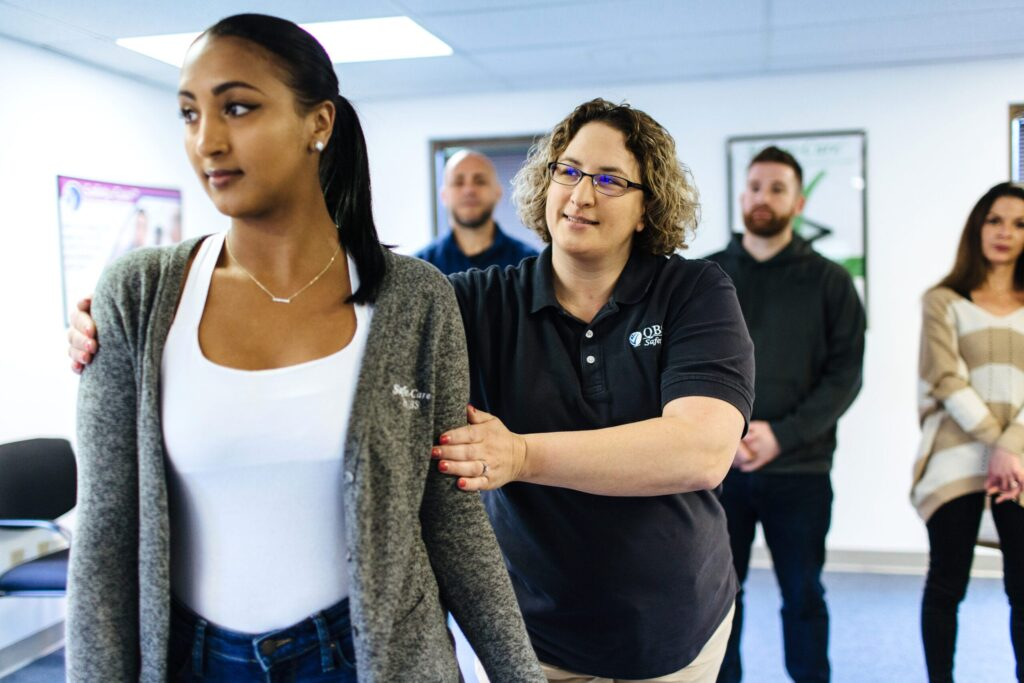Arizona – State Statutes Title 15, Article 1, 15-105: Use of restraint and seclusion techniques
Article 1, 15-105 focuses entirely on the use of restraint and seclusion in schools within the state of Arizona. These guidelines set new standards for schools. Below is a summary of 15-105 and descriptions of how Safety-Care can be used to meet the needs of school districts throughout the state.
.jpg)
.png?width=88&height=95&name=Group%20137%20(5).png)


How to Implement Safety-Care?
-
Register for a Safety-Care Trainer class or call us to request a closed session for your organization. We regularly conduct classes in all 50 states and Canada.
-
Complete your class to become a certified Safety-Care Trainer for your organization. We bring you to fluency using an errorless teaching methodology.
-
You train and certify your staff in Safety-Care’s effective techniques.
-
Our Master Trainers are available by phone, email, or video to help your organization with any questions or concerns while using or implementing Safety-Care.

Legal Requirements
|
Summary: Last Amended Date: January 2024 Last Updated: December, 2024 Article 1, 15-105 focuses entirely on the use of restraint and seclusion in schools within the state of Arizona. These guidelines set new standards for schools. Below is a summary of 15-105 and descriptions of how Safety-Care can be used to meet the needs of school districts throughout the state. |
|
A. Conditions for Use: 1. Restraint or seclusion techniques may only be used if the pupil's behavior poses an imminent danger of bodily harm to themselves or others. |
|
B. Requirements for Use: 1. Continuous visual observation and monitoring of the pupil must be maintained while the restraint or seclusion technique is in use. How Safety-Care aligns: Safety-Care focuses on the use of Incident Prevention prior to the use of any physical intervention. All personnel are trained to treat the persons under their care in a humane and professional manner. Our program emphasizes de-escalation as a primary strategy before the use of physical interventions. If physical interventions are needed, Safety-Care ensures that the practices that are trained and used are as safe and appropriate as possible to both staff and student. |
|
C. Policies and Procedures: Schools may establish policies and procedures for using restraint or seclusion techniques in a school safety or crisis intervention plan, provided the plan is not specific to any individual pupil. |
|
D. Reporting and Documentation: 1. Parents or guardians must be notified on the same day as the incident, unless circumstances prevent same-day notification. If not possible, notice must be given within 24 hours. |
|
E. Law Enforcement Involvement: If law enforcement is summoned instead of using restraint or seclusion techniques, schools must still comply with reporting, documentation, and review procedures. School Resource Officers are authorized to respond according to the regulations set by their law enforcement agency. How Safety-Care aligns: Safety-Care trains educators in specific actions related to physical management that are only to be used when necessary for safety, and with the utmost care for students and staff using such actions. Safety-Care stresses the risks involved in such actions, both physical and psychological. Additionally, Safety-Care has internal reporting requirements that must be used to supplement existing regulations regarding the use of these physical actions. |
|
F. Exception: This section does not prohibit schools from adopting policies pursuant to another section of the law. |
|
G. Definitions: 1. Defines "restraint" as any method or device that limits a pupil's ability to move freely, excluding certain approved therapeutic or safety purposes. Exemptions are set for therapeutic or safety purposes as well as temporary touching in an effort to encourage compliance. Holding a student for the purpose of calming or comfort is also exempted. Physical force is allowed to remove a weapon from a student or to separate a physical assault. Overall, the law emphasizes the importance of safety, proper training, documentation, and parental notification in the use of restraint and seclusion techniques in schools. It aims to ensure these techniques are used only when necessary and in a manner that respects the dignity and well-being of students. |
Why Safety-Care?
Benefits & Differentiators
In addition to Safety-Care being highly cost-effective, you get:

Skills to effectively prevent, minimize, & manage behavioral challenges with dignity, safety, & the possibility of change

Decreases in staff and patient injuries and reduction in restraint & seclusion time

Instructional procedures based on decades of evidence-based research & compatible with ABA, PBIS & reinforcement-based environments

Customizable program for your setting, staff & clientele, with a strong focus on preventative via non-intrusive, replacement behaviors

Extremely rigorous standards grounded in errorless teaching methodology

Small, intimate class sizes backed by unlimited support & resources
How Is Safety-Care So Effective?
A Genuine Focus on Implementing & Managing Positive Behavioral Skills
Proactive, environmental management recommendations
Understanding of evocative effects of staff behavior
In-depth analysis of antecedents and proactive antecedent interventions
Evidence-based reinforcement procedures
Required competency in de-escalation skills
Humane, non-invasive touch and QBS Check™ strategies
Evidence-based teaching procedures
Applicable to a wide array of settings, conditions & challenging behavior





